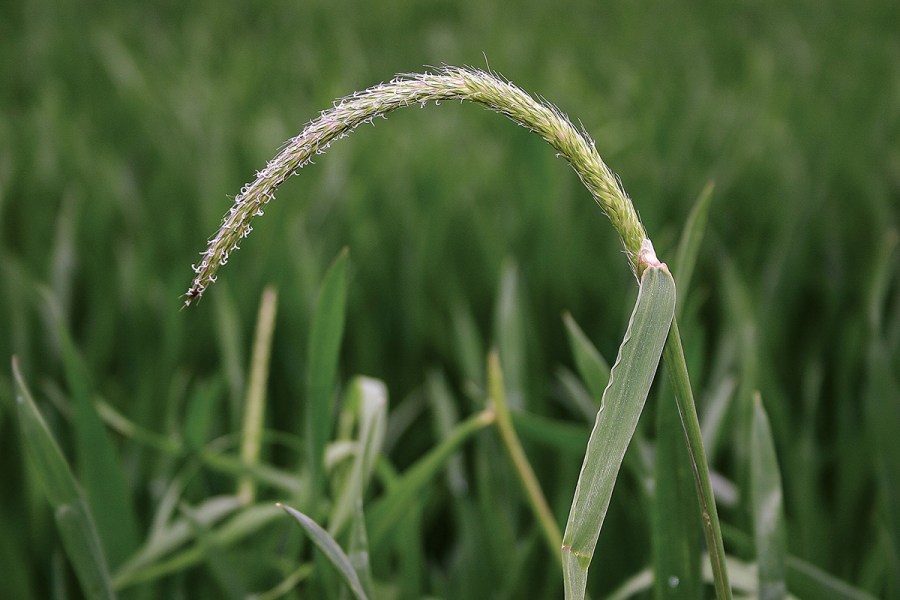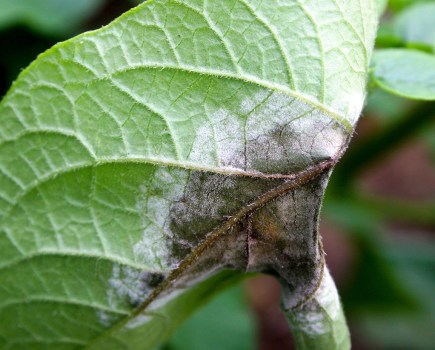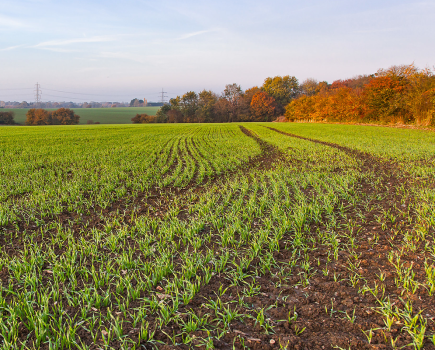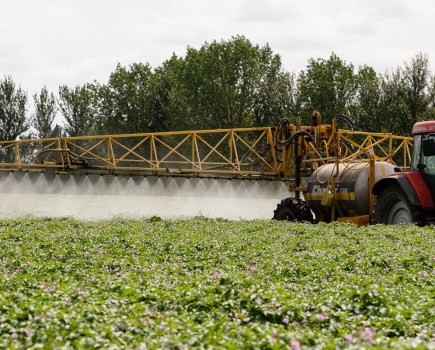As growers head into autumn following the back of a particularly challenging grassweed year, now is the time to hit weeds hard. CPM learns how to maximise pre-emergence herbicide treatments to give crops a fighting chance.
“From a farmer’s perspective, you can see a visible benefit and that the chemistry is doing a better job.”
By Janine Adamson
Guaranteed optimum seedbed conditions would make crop production considerably easier and less risky. However, this is the UK, where it’s often all or nothing, particularly when it comes to the weather.
For many, last season was a prime example – dry conditions not only hindered the impact of cultural control methods such as stale seedbeds, but also reduced the efficacy of crop production inputs too. Interagro’s Stuart Sutherland says the weather has always been one of the biggest challenges for farmers, and it’s now putting even more pressure on herbicide programmes.
“Last autumn was quite a battle in terms of conserving soil moisture; dry seedbeds reduce herbicide activation and uptake, as well as diminish the grassweed flush ahead of crop emergence,” he explains.
“Conversely, heavy rainfall is problematic too because it impacts spray conditions and field travel. Unfortunately there’s likely to be a high weed seed-bank this year as a result of poor control last season.”
According to Stuart, although selecting different modes of action can help to tackle problem weeds, increasing the stack can also risk crop safety, especially when followed by a deluge. Therefore boosting herbicide performance under adverse conditions is becoming an increasing priority.
“This is where adjuvants come in – they play an important role within the IPM toolbox. Adding an adjuvant to a pre-emergence herbicide programme is a key action towards achieving more efficient and consistent weed control,” he says.
The benefits of adjuvants are well publicised, namely their ability to enhance product coverage and reduce spray drift. However, an added bonus of Backrow Max is that it increases herbicide and moisture levels in the weed germination zone (0-5cm soil depth), which could pay dividends for growers this autumn.
“This retention characteristic of Backrow Max not only boosts residual activity under adverse conditions such as wet weather, to the other end of the spectrum, it lowers dependency on rainfall for herbicide activation and uptake,” says Stuart.
“Applications are not only more efficient – increasing the longevity of weed control by up to eight weeks – they’re also more resilient to the challenging weather conditions which threaten effective weed control.”
Heavy rainfall is a problem because it can speed up the leaching process, particularly in lighter soils. And although all herbicides have unique chemical properties with different mobility and soil-binding abilities, Stuart says such weather can cause even the likes of pendimethalin to migrate from the critical weed germination zone.
Posing the greatest threat are herbicides with high mobility and low absorption to soil particles, such as metribuzin. To overcome this risk, Backrow Max has been shown to reduce chemical leaching by as much as 60%, as demonstrated during controlled lysimeter work conducted in The Netherlands.
And whereas leaching might typically be thought of as a problem for environmental stewardship and watercourse management, Stuart says Backrow Max also minimises the risk of products entering the root zone of the crop itself.
But does the adjuvant continue to offer the same ‘classic’ benefits of such products? Independent trials by Silsoe Spray Applications Unit suggest so – when added to a tank of 0.6 l/ha of Liberator (flufenacet+ diflufenican), 0.2 l/ha of Backrow Max reduced the number of drift-prone spray particles by 35%.
“It’s well acknowledged that robust herbicide coverage across the soil surface is crucial for effective pre-em performance. Spray drift and clods can cause coverage ‘weak spots’, allowing weeds to find a way through,” comments Stuart. “Backrow Max ensures optimum droplet size, helping to create a stronger barrier to block weed germination.
“Pushing pre-em efficacy and gaining a few extra percentage points in blackgrass control could help growers to achieve the 98% control required to get on top of populations. But its in tricky application/weather conditions where Backrow Max can make the biggest difference.”
Again, trials (Agrii 2020) support Interagro’s claim, even for the ever troublesome weed, blackgrass. For example, the efficacy of Octavian Met (flufenacet+ diflufenican+ aclonifen) plus Pontos (flufenacet+ picolinafen) in winter wheat was boosted by 12% when Backrow Max was in the tank (53 less heads/m2 and 5,300 less seeds/m2 returning to the soil).
For brome, a grassweed increasing in prevalence, the action of Luxinum Plus (cinmethylin) plus Orient (pendimethalin+ piconlinafen) was improved by 8% in one of the 2020 Agrii trials. And finally, for ryegrass control in winter wheat, an 18% uplift of a Giddo (flufenacet+ diflufenican) + Bandur (aclonifen) treatment.
But, it’s important to recognise that an uplift of just a few percent can make a notable difference to seed return. In 2022 Prime Crop Research trials, Backrow Max added a 4% uplift in the blackgrass control of Luxinum Plus. With 239 heads recorded in the untreated plot, the reduction of nine blackgrass heads in the Backrow Max plot reduced seed return by 900 seeds/m2.
However, how does the product perform on-farm? Stephen May, arable foreman at Fromant and Sanders in Northamptonshire, confirms that Backrow Max delivers the goods. He says the farm’s been using the product for around three years across variable soil types.
“I was first introduced to the product by our Agrii agronomist – the company had undertaken their own trials which showed good results so I was happy to take the recommendation. We now use Backrow Max in our pre-ems across winter wheat and barley crops, and will also consider it for spring barley,” he says.
The farm’s currently operating a rotation of wheat, barley, oats, oilseed rape and beans, with a move towards reducing the area of OSR.
For Stephen, the problem mainly lies in blackgrass control, which he manages through stale seedbeds, selectively ploughing high pressure areas, and spring cropping. Whereas in the past the weed might have been isolated to heavier land, he says that’s no longer the case. “During the past five years or so it’s certainly been creeping into our lighter soils, which come with their own challenges in terms of chemical retention.”
With cultural control his first port of call, Stephen then follows with a robust pre-em spray which includes a combination of Luxinum Plus with Pontos (flufenacet+ picolinafen) or Orient (pendimethalin+ picolinafen), depending on the scenario. “Few options seem to work these days for post-em, so it’s even more critical to get a clean start. Backrow Max essentially pumps up the residual chemistry, retaining it in the soil profile where it’s most important,” he says.
As per many growers, the farm found 2022/23 a challenge with higher blackgrass populations than in previous years. Stephen has also noted hemlock starting to creep in around field margins, which he says he’s monitoring closely.
Another grower using Backrow Max is Jon Sensecall from Lower Tomlow Farm in Warwickshire. He says despite using every tool in the cultural control toolbox, from delayed drilling to spring cropping, blackgrass continues to have an impact.
As a result, he’s been concentrating on optimising sprayer application including nozzle selection and reconsidering what goes into the tank. “We recently moved over to the Lechler IDTA nozzles [asymmetrical twin flat spray air-injector], and so far I’m impressed with the improved droplet size and coverage,” says Jon.
“Using the correct water rate is key – a minimum of 200 l/ha for a pre-em and up to 250-300 l/ha if required. I’m also a firm believer in driving the sprayer as slow as possible, which within our system is around 10km/h. You might risk travelling a little faster and think you can get away with it, but the results speak for themselves.”
Jon says using Backrow Max is another piece of the application puzzle, adding it to all pre- and peri-emergence herbicide applications across spring and autumn crops. And because he’s using newer options such as Luxinum Plus, he says it pays to maximise activity and therefore boost return on investment.
“Inputs on the whole aren’t cheap but adding Backrow Max is a cost-effective way to increase control. Although the official data is always impressive, from a farmer’s perspective, you can see a visible benefit and that the chemistry is doing a better job,” he says.
Tillage-wise, like many growers, Jon hasn’t used the plough for a number of years and recently started to use a low disturbance subsoiler followed by discs to prepare the seedbeds of his mostly heavy soils. “The aim is to keep the weed seed-bank as close to the surface as possible to achieve a decent flush ahead of planting.
“With the new leaching data for Backrow Max showing its ability to retain chemistry within 0-5cm, I hope it works to our advantage this coming year,” he concludes.
This article was taken from the latest issue of CPM. Read the article in full here.
For more articles like this, subscribe here.
Sign up for Crop Production Magazine’s FREE e-newsletter here.




